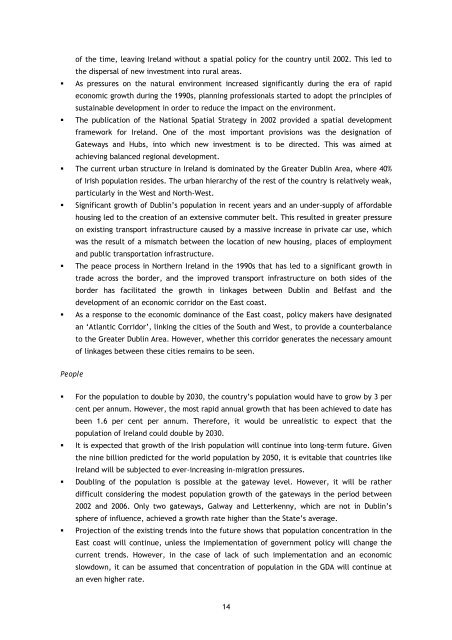TWICE THE SIZE - DIT Update - Dublin Institute of Technology
TWICE THE SIZE - DIT Update - Dublin Institute of Technology
TWICE THE SIZE - DIT Update - Dublin Institute of Technology
Create successful ePaper yourself
Turn your PDF publications into a flip-book with our unique Google optimized e-Paper software.
<strong>of</strong> the time, leaving Ireland without a spatial policy for the country until 2002. This led to<br />
the dispersal <strong>of</strong> new investment into rural areas.<br />
As pressures on the natural environment increased significantly during the era <strong>of</strong> rapid<br />
economic growth during the 1990s, planning pr<strong>of</strong>essionals started to adopt the principles <strong>of</strong><br />
sustainable development in order to reduce the impact on the environment.<br />
The publication <strong>of</strong> the National Spatial Strategy in 2002 provided a spatial development<br />
framework for Ireland. One <strong>of</strong> the most important provisions was the designation <strong>of</strong><br />
Gateways and Hubs, into which new investment is to be directed. This was aimed at<br />
achieving balanced regional development.<br />
The current urban structure in Ireland is dominated by the Greater <strong>Dublin</strong> Area, where 40%<br />
<strong>of</strong> Irish population resides. The urban hierarchy <strong>of</strong> the rest <strong>of</strong> the country is relatively weak,<br />
particularly in the West and North-West.<br />
Significant growth <strong>of</strong> <strong>Dublin</strong>’s population in recent years and an under-supply <strong>of</strong> affordable<br />
housing led to the creation <strong>of</strong> an extensive commuter belt. This resulted in greater pressure<br />
on existing transport infrastructure caused by a massive increase in private car use, which<br />
was the result <strong>of</strong> a mismatch between the location <strong>of</strong> new housing, places <strong>of</strong> employment<br />
and public transportation infrastructure.<br />
The peace process in Northern Ireland in the 1990s that has led to a significant growth in<br />
trade across the border, and the improved transport infrastructure on both sides <strong>of</strong> the<br />
border has facilitated the growth in linkages between <strong>Dublin</strong> and Belfast and the<br />
development <strong>of</strong> an economic corridor on the East coast.<br />
As a response to the economic dominance <strong>of</strong> the East coast, policy makers have designated<br />
an ‘Atlantic Corridor’, linking the cities <strong>of</strong> the South and West, to provide a counterbalance<br />
to the Greater <strong>Dublin</strong> Area. However, whether this corridor generates the necessary amount<br />
<strong>of</strong> linkages between these cities remains to be seen.<br />
People<br />
For the population to double by 2030, the country’s population would have to grow by 3 per<br />
cent per annum. However, the most rapid annual growth that has been achieved to date has<br />
been 1.6 per cent per annum. Therefore, it would be unrealistic to expect that the<br />
population <strong>of</strong> Ireland could double by 2030.<br />
It is expected that growth <strong>of</strong> the Irish population will continue into long-term future. Given<br />
the nine billion predicted for the world population by 2050, it is evitable that countries like<br />
Ireland will be subjected to ever-increasing in-migration pressures.<br />
Doubling <strong>of</strong> the population is possible at the gateway level. However, it will be rather<br />
difficult considering the modest population growth <strong>of</strong> the gateways in the period between<br />
2002 and 2006. Only two gateways, Galway and Letterkenny, which are not in <strong>Dublin</strong>’s<br />
sphere <strong>of</strong> influence, achieved a growth rate higher than the State’s average.<br />
Projection <strong>of</strong> the existing trends into the future shows that population concentration in the<br />
East coast will continue, unless the implementation <strong>of</strong> government policy will change the<br />
current trends. However, in the case <strong>of</strong> lack <strong>of</strong> such implementation and an economic<br />
slowdown, it can be assumed that concentration <strong>of</strong> population in the GDA will continue at<br />
an even higher rate.<br />
14








